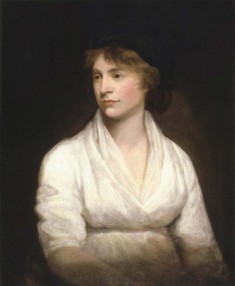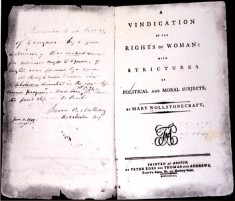| Mary Wollstonecraft | |
|---|---|
 |
|
| Philosopher | |
| Specialty | Feminist philosophy |
| Born | Apr. 27, 1759 |
| Died | Sep. 10, 1797 |
| Nationality | English |
Mary Wollstonecraft was an English philosopher, author, and women’s rights advocate. Despite dying before the age of 40, she published a large number of works, ranging from novels to history books and even a conduct book. Her most important philosophical work, Vindication of the Rights of Woman, was a call for better women’s education and an appeal for reason to become the basis of society at large. She had an unconventional personal life which included multiple affairs. She was the mother of Mary Wollstonecraft Godwin, who under the name Mary Shelley, published Frankenstein.
Early Years
Wollstonecraft was born in London on April 27, 1759. The family was neither influential nor rich, and Mary’s father was unable to hold down a long-term job to bring stability to his wife and children. As well as his professional failures, he was also something of an abusive person, being especially unkind to his wife, Mary’s mother.
Mary often found herself having to comfort and protect her mother, and this experience informed a number of her later writings which were critical of the institution of marriage. In her teens, Mary began a long-term friendship with Fanny Blood, and when Mary’s mother died in 1780, she went to live with Fanny’s family.
Teaching Career
In 1784, unhappy about the lack of professional openings available to women, Wollstonecraft made the decision to open a school in Islington, with her sister Eliza and Fanny Blood to help her. They found the inner-city location unpleasant and quickly set in train moves to have it transferred to Newington Green, a leafier northern suburb.
Here, another sister, Everina, joined them. The school was visited by Samuel Johnson. In 1785, Blood left for Portugal in order to marry. Shortly afterward, she became pregnant and wrote to Wollstonecraft asking her to come to Portugal to keep her company until the child was born. Wollstonecraft put personal loyalties ahead of professional success and traveled to Lisbon, but tragedy awaited her: Blood died in childbirth, and her child lived for only a short time thereafter. Wollstonecraft was deeply upset and wove the experience into Mary: A Fiction, her debut novel of 1788.
Wollstonecraft Back in England
 Wollstonecraft returned to find her school in such severe financial difficulties that she had to shut it down. She wrote a conduct book, Thoughts on the Education of Daughters, which was published by the prominent liberal, Joseph Johnson, in 1787. The modest income from sales of this book was not sufficient for Wollstonecraft to support herself, and she went to Ireland to work as a governess for the two daughters of Viscount Kingsborough.
Wollstonecraft returned to find her school in such severe financial difficulties that she had to shut it down. She wrote a conduct book, Thoughts on the Education of Daughters, which was published by the prominent liberal, Joseph Johnson, in 1787. The modest income from sales of this book was not sufficient for Wollstonecraft to support herself, and she went to Ireland to work as a governess for the two daughters of Viscount Kingsborough.
She spent about 18 months in this position, and she came to loathe what she saw as the demeaning nature of the governess’s role, something that shines through in several of her published works; the first of these, Original Stories from Real Life, appeared in 1788.
Becoming a Writer
By now, Wollstonecraft had resolved that, if she could not earn a living as a teacher, she would do so as a writer. She became a translator from French and wrote pieces for the Analytical Review, a periodical owned by Johnson. Johnson held weekly dinners, and here Wollstonecraft met several of the age’s greatest radical philosophers, including William Blake, Thomas Paine, and William Godwin.
In this circle of liberal intellectuals, Wollstonecraft felt quite at home, and she began to attack conservative thinkers such as Edmund Burke in a way previously thought shocking for a woman. A Vindication of the Rights of Man, published in 1790, was a strong disputation of Burke’s support for the landed gentry. Two years later, its companion piece, A Vindication of the Rights of Woman, proved Wollstonecraft’s clear, deep understanding of her subject.
Wollstonecraft’s Later Years
Wollstonecraft traveled to revolutionary France in 1792, publishing a book about its morality two years later. In Paris, she met an American businessman, Gilbert Imlay, and the two began a relationship. She was in some danger from the Great Terror and Imlay hid her away, first in the U.S. Embassy and later in Le Havre, pretending to be her husband.
The couple had a daughter, Fanny, in 1794. Instead of remaining at home to care for her as the conventions of the time dictated, Wollstonecraft took the infant with her on one of Imlay’s business trips in Scandinavia. From this journey came a book of letters. They end with her anticipating imminent disaster – and indeed, returning to London she discovered that Imlay had left her.
Death and Legacy
Wollstonecraft was so upset by this turn of events that she made an unsuccessful suicide attempt by jumping from Putney Bridge. She recovered, and a renewed friendship with William Godwin became an affair. She became pregnant, and the pair was married in 1797. The marriage came as something of a surprise to both of them, since both parties had previously spoken out against what they saw as the suffocating restrictiveness of marriage.
Later that year, Wollstonecraft’s daughter was born but, although the child herself was healthy, her mother suffered a placental infection. Nothing could be done to save her, and she died on September 10, 1797, just 11 days after the birth.